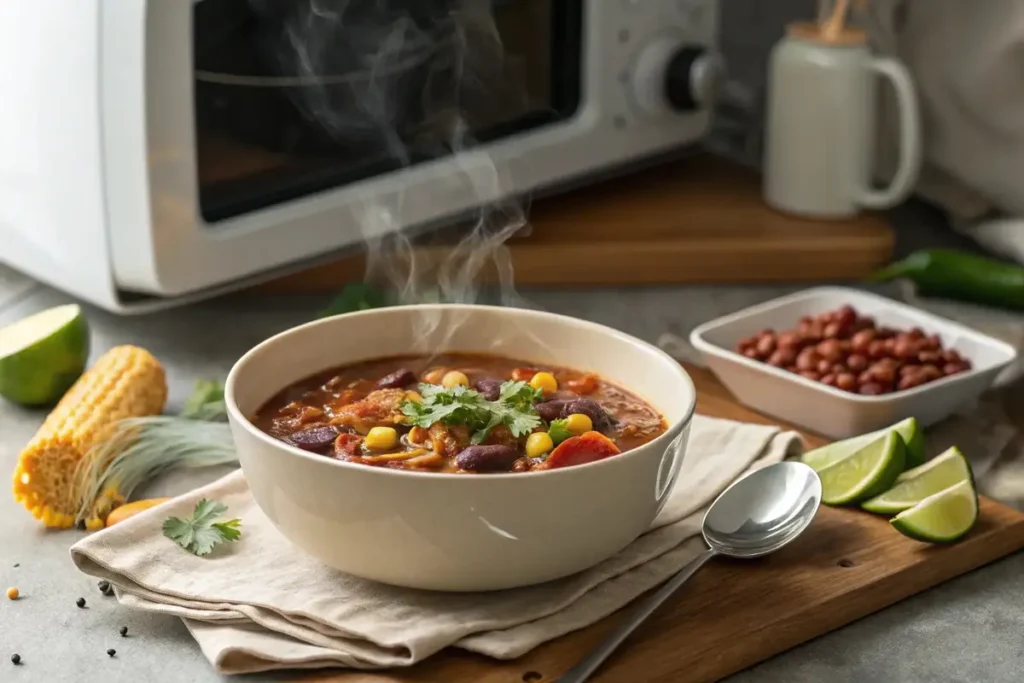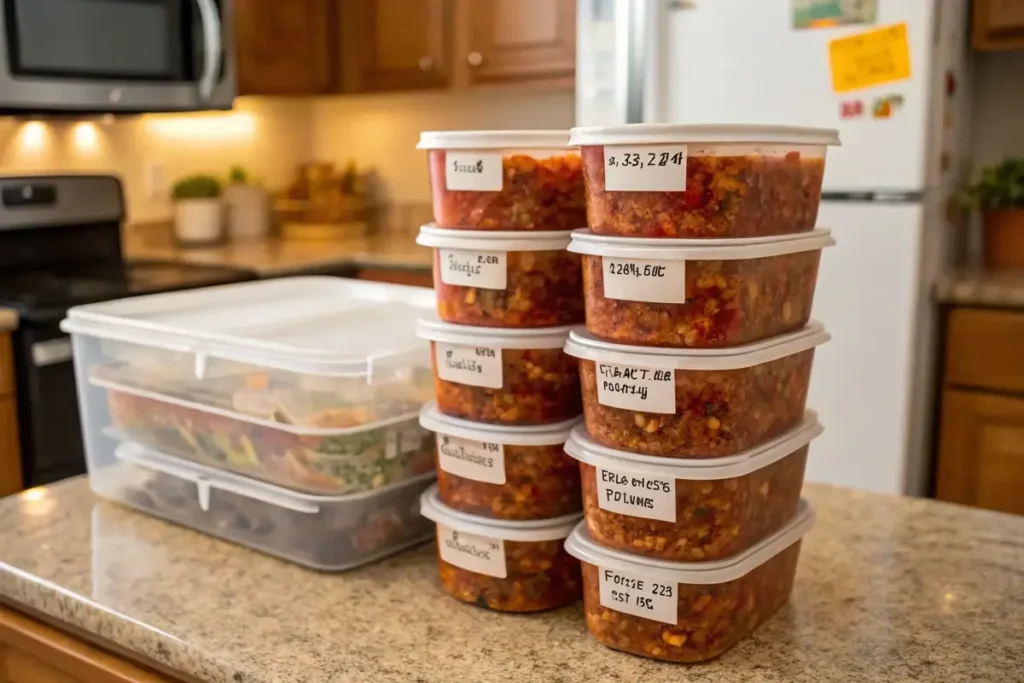Introduction
Taco soup is a crowd-pleasing dish that combines hearty ingredients and bold flavors. Whether you’re reheating leftovers from a weeknight dinner or defrosting a batch from the freezer, knowing how to reheat taco soup properly can make all the difference. The wrong method can leave you with uneven heating or a loss of flavor, but don’t worry—this guide covers the best techniques to reheat taco soup while preserving its delicious taste and texture.
Understanding Taco Soup and Its Ingredients
What Is Taco Soup?
Taco soup is a flavorful dish that brings together the best elements of a taco in a warm, comforting bowl. It’s typically made with:
- Protein: Ground beef, chicken, or turkey.
- Legumes: Black beans, pinto beans, or kidney beans.
- Vegetables: Corn, diced tomatoes, and onions.
- Spices: Taco seasoning, chili powder, and cumin.
This soup is often topped with garnishes like shredded cheese, sour cream, avocado slices, or crushed tortilla chips for added flavor and texture.
Why Reheating Taco Soup Requires Care
Reheating taco soup isn’t as simple as warming it up—there’s a fine balance to maintain:
- Preserving Texture: Overcooking can turn beans mushy or vegetables too soft.
- Maintaining Flavor: Excessive heat can dull the spices or cause the soup to lose its original zest.
- Avoiding Uneven Heating: Without the right approach, you risk scorching the bottom while the top stays lukewarm.
By understanding the composition of taco soup, you’ll see why each method of reheating comes with its own set of best practices.
Best Methods to Reheat Taco Soup
Reheating taco soup the right way ensures that every bowl tastes just as good as when it was first made. Whether you’re using the stove, microwave, slow cooker, or oven, following the proper techniques will maintain the flavor, texture, and overall enjoyment of this hearty dish.
Reheating Taco Soup on the Stove
Step-by-Step Instructions
- Choose the Right Pot: Use a medium-sized pot or saucepan with a heavy bottom to prevent scorching.
- Set the Heat: Place the pot on low to medium heat for gradual warming.
- Add the Soup: Pour the taco soup into the pot and stir to distribute ingredients evenly.
- Stir Frequently: Stir the soup every 1–2 minutes to prevent sticking or burning at the bottom.
- Heat to Your Liking: Once the soup reaches the desired temperature, remove it from the heat and serve immediately.
Pros and Cons
Pros:
- Even heating ensures all ingredients are warmed uniformly.
- Allows you to adjust seasonings or add fresh toppings during the process.
Cons:
- Requires constant attention and stirring to avoid sticking.
- Can take longer compared to other methods.
Reheating Taco Soup in the Microwave
Step-by-Step Instructions
- Choose a Microwave-Safe Container: Use a glass or ceramic bowl with a loose-fitting lid to prevent splatters.
- Portion the Soup: Heat smaller portions to ensure even warming.
- Set the Timer: Heat on high for 1–2 minutes.
- Stir and Continue Heating: Remove the soup, stir thoroughly, and heat for another 1–2 minutes until warmed evenly.
Tips for Microwaving
- Cover Lightly: Use a microwave-safe lid or a damp paper towel to trap steam without creating a vacuum.
- Stir Between Intervals: This avoids hot spots and ensures uniform heating.
- Don’t Overheat: Heating too long can make ingredients like beans or vegetables mushy.

Reheating Taco Soup in a Slow Cooker
Step-by-Step Instructions
- Prepare the Slow Cooker: Set it to the low or warm setting.
- Add the Soup: Pour the taco soup into the slow cooker.
- Cover and Heat: Let the soup warm for 1–2 hours, stirring occasionally.
- Serve: Once it’s thoroughly heated, ladle the soup into bowls and add desired toppings.
Best Situations for Using a Slow Cooker
- Perfect for reheating large portions.
- Ideal for meal prepping or serving at gatherings where the soup can be kept warm for hours.
Reheating Taco Soup in the Oven
Step-by-Step Instructions
- Preheat the Oven: Set it to 350°F (175°C).
- Choose a Covered Dish: Use an oven-safe dish with a lid or cover it tightly with aluminum foil to retain moisture.
- Add the Soup: Transfer the taco soup to the dish.
- Bake: Heat for 20–30 minutes, stirring halfway through.
- Check and Serve: Ensure the soup is heated through and serve immediately.
Best Practices for Oven Reheating
- Prevent Drying Out: Add a splash of broth or water before reheating to maintain the soup’s consistency.
- Avoid Overheating: Monitor closely to prevent drying out the top layer.
Reheating Frozen Taco Soup
Reheating frozen taco soup can seem daunting, but with a few simple steps, you’ll have a delicious meal ready in no time.
How to Defrost Taco Soup Before Reheating
Refrigerator Thawing
- Place the frozen container of taco soup in the fridge overnight.
- This is the safest method, as it keeps the soup at a safe temperature while thawing.
Quick Defrosting Options
- Microwave: Use the defrost setting to thaw the soup in intervals, stirring frequently.
- Water Bath: Submerge the sealed container in cold water, changing the water every 30 minutes until the soup is thawed.
Reheating Frozen Taco Soup Directly
If you’re short on time, taco soup can be reheated straight from the freezer:
- Use a Pot on the Stove:
- Add the frozen soup to a pot and set the heat to low.
- Stir frequently as it thaws and reheats simultaneously.
- Microwave Method:
- Place the frozen soup in a microwave-safe container.
- Use the defrost setting, stirring at regular intervals, and then heat as usual.
- Oven Method:
- Preheat the oven to 350°F (175°C).
- Place the frozen soup in a covered oven-safe dish and bake for 40–50 minutes, stirring occasionally.
Maintaining Texture and Flavor
- Refresh the Soup: Add fresh toppings like shredded cheese, sour cream, or avocado to enhance the flavor.
- Adjust the Consistency: If the soup appears too thick, add a splash of broth or water during reheating.
- Season After Reheating: Taste the soup and add salt, spices, or lime juice as needed to revive the flavors.
Common Mistakes to Avoid
Reheating taco soup is straightforward, but avoiding a few common pitfalls ensures you’ll get the best results every time.
Overheating the Soup
Excessive heat can ruin taco soup in several ways:
- Texture Changes: Beans become mushy, and vegetables lose their structure.
- Flavor Loss: Spices can break down, dulling the soup’s bold taste.
To prevent this, use low to medium heat and monitor closely during reheating. Gradual warming retains the soup’s integrity and flavor.
Neglecting to Stir
When reheating, it’s crucial to stir the soup regularly:
- Avoid Hot Spots: Uneven heating can leave some parts cold while others are overcooked.
- Prevent Scorching: Stirring ensures the soup doesn’t stick to the bottom of the pan or microwave-safe dish.
Always stir at intervals, whether using the stove, microwave, or oven.
Using the Wrong Container
Choosing the right container can make all the difference:
- Microwave-Safe: Use glass or microwave-safe plastic to avoid leaching chemicals or causing the container to warp.
- Oven-Safe: Avoid regular plastic containers; instead, opt for ceramic or glass dishes designed for oven use.
Double-check container labels for compatibility with your reheating method.
Tips for Storing and Reheating Taco Soup
Proper storage and reheating techniques are essential to keeping taco soup fresh and delicious.
Proper Storage of Leftover Taco Soup
Storing in Airtight Containers
- Choose the Right Container: Use airtight containers to prevent moisture loss and odor transfer.
- Cool Before Storing: Let the soup cool to room temperature before sealing to avoid condensation.
- Refrigeration: Store in the fridge for up to 4 days.
Freezing Tips for Long-Term Storage
- Use Freezer-Safe Bags or Containers: Label each with the date for easy tracking.
- Portioning: Divide into individual servings for quicker reheating.
- Avoid Overfilling: Leave some space to account for expansion during freezing.

Enhancing Reheated Taco Soup
Adding Fresh Toppings
- Elevate your reheated soup with garnishes like:
- Shredded cheese.
- Sour cream.
- Avocado slices.
- Fresh cilantro or green onions.
These toppings add freshness and texture to reheated soup.
Adjusting Seasoning After Reheating
- Taste Test: Flavors may dull after storage, so adjust spices as needed.
- Add Liquid: If the soup feels too thick, stir in some broth or water.
By following these tips, your taco soup will taste just as flavorful as when it was freshly made.
Frequently Asked Questions (FAQs)
Reheating taco soup might bring up some common questions. Below are answers to help you store, reheat, and enjoy your soup without any hassle.
Can I reheat taco soup multiple times?
Yes, you can reheat taco soup multiple times, but it’s best to limit reheating to just once to maintain the texture and flavor. Each time you reheat, the soup’s ingredients, like beans and vegetables, may break down further, altering the overall quality. Portion the soup into smaller containers to reheat only what you need.
How long can taco soup be stored in the fridge?
Taco soup can be safely stored in the refrigerator for up to 4 days. Ensure it’s kept in an airtight container to preserve freshness and prevent odor transfer from other foods. Label the container with the storage date for easy reference.
Can I reheat taco soup in a pressure cooker?
Yes, a pressure cooker can be a convenient way to reheat taco soup, especially for large portions. Use the “warm” or “low-pressure” setting to gently heat the soup. Be sure to stir occasionally and monitor the temperature to avoid overcooking.
What’s the best way to reheat taco soup without it drying out?
To keep taco soup moist, add a splash of broth or water before reheating. This works especially well when reheating on the stove or in the oven. Covering the soup with a lid while reheating also helps retain moisture and prevent drying.
How do I know if leftover taco soup has gone bad?
Spoiled taco soup may have a sour smell, a change in color, or an unusual texture. If you notice mold or it’s been in the fridge for more than 4 days, discard it. Always trust your senses when in doubt about food safety.
Enjoy Perfectly Reheated Taco Soup Every Time
Recap of the Best Reheating Methods and Tips
Reheating taco soup is simple when you choose the right method. From the stovetop to the microwave, or even using a slow cooker, there’s a solution for every situation. Ensuring proper storage and reheating techniques will preserve the soup’s flavor and texture.
Encouragement to Try Different Techniques
Don’t hesitate to experiment with various reheating methods to find what works best for you. Each approach offers unique benefits, whether you need a quick microwave fix or the flavor-enhancing slow cooker method.
Final Thoughts on Taco Soup as a Versatile Meal
Taco soup is not just a delicious dish—it’s also incredibly adaptable. Reheating leftovers can bring the same joy as the first serving, especially when paired with fresh toppings or a side of warm tortillas. With these tips, you can enjoy taco soup anytime, hassle-free!

